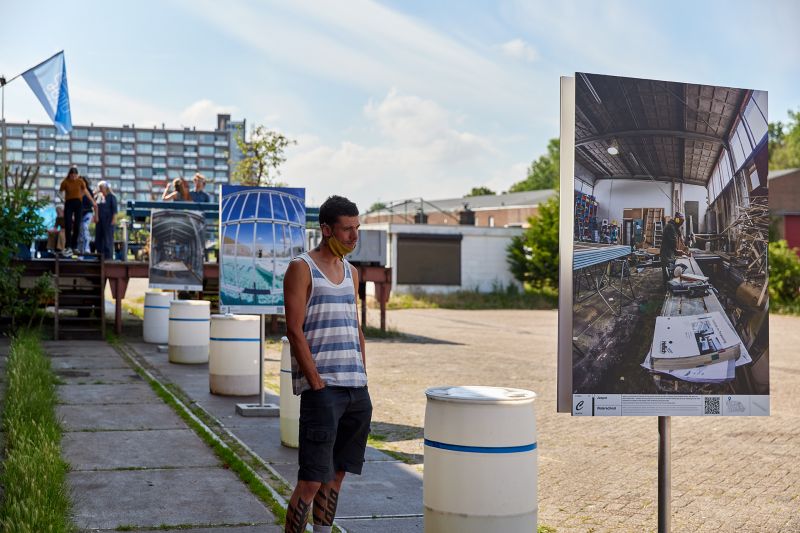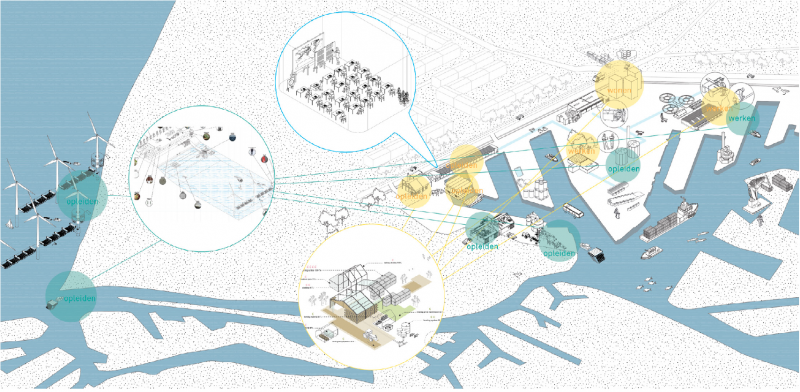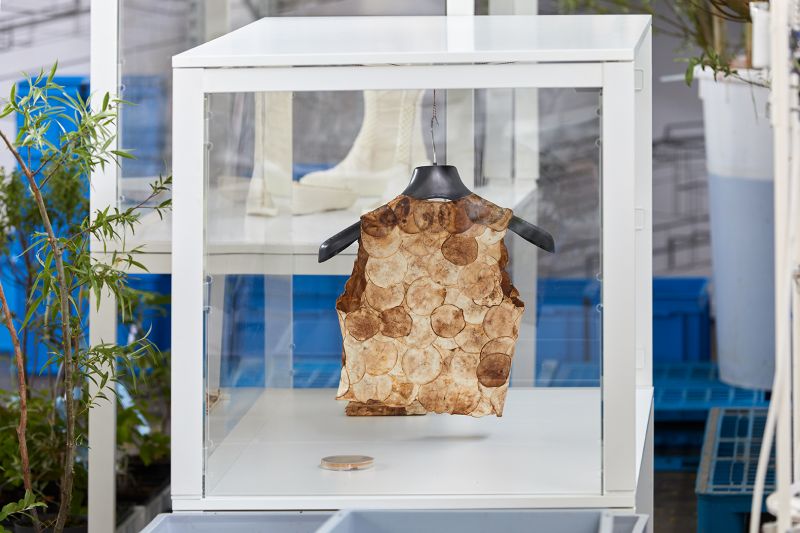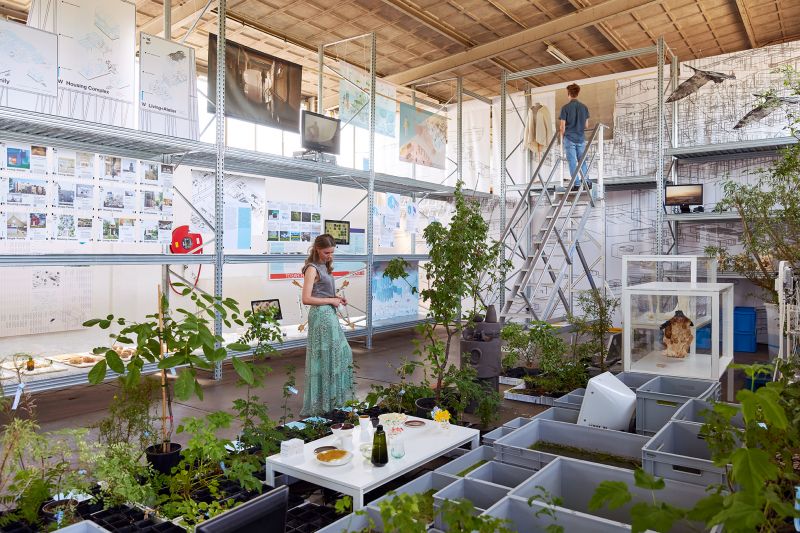
DOWN TO EARTH: WATERSCHOOL M4H+
image: Aad Hoogendoorn
In their studio on the western edge of Merwe-Vierhavens (M4H), Makkink & Bey have set up a working exhibition that illustrates what a new live-work environment could look like if the points of view and use of raw materials of future residents are taken into account.

WATERSCHOOL M4H+ Insects Scenario Visualization
artist's impression Studio Makkink & Bey with Juhee Hahm
Future scenarios
The exterior of the elongated building and the exhibition feature drawn future scenarios that also include existing projects by designers, artists, and architects. They portray a new relationship between all living organisms, including all residents, in a district that focuses on energy, water management, and food. The drawings of food, material, energy, and live-work landscapes demonstrate how M4H can be (re)developed. The work creates a cultural framework that serves as an addition to and is informed by the guiding principles formulated by the IABR–Atelier Rotterdam for the development of M4H that were integrated into the Spatial Framework approved by the Port Authority and the City of Rotterdam in 2019.

WATERSCHOOL M4H+ - detail
image: George Brugmans
Waterschool: an ongoing project
WATERSCHOOL M4H+ is the next step in the development of the Waterschool, a long-term research project by Studio Makkink & Bey (SMB) that was also part of the previous biennale, THE MISSING LINK.
Curators Rianne Makkink and Jurgen Bey started exploring Merwe-Vierhavens (M4H) as a learning production landscape that was being developed to meet the water challenge in 2018. Now, two years later, they proudly present WATERSCHOOL M4H+: the culmination of their research in a working exhibition in their own studio, complemented by five installations at five different outdoor locations in former city harbor area M4H.
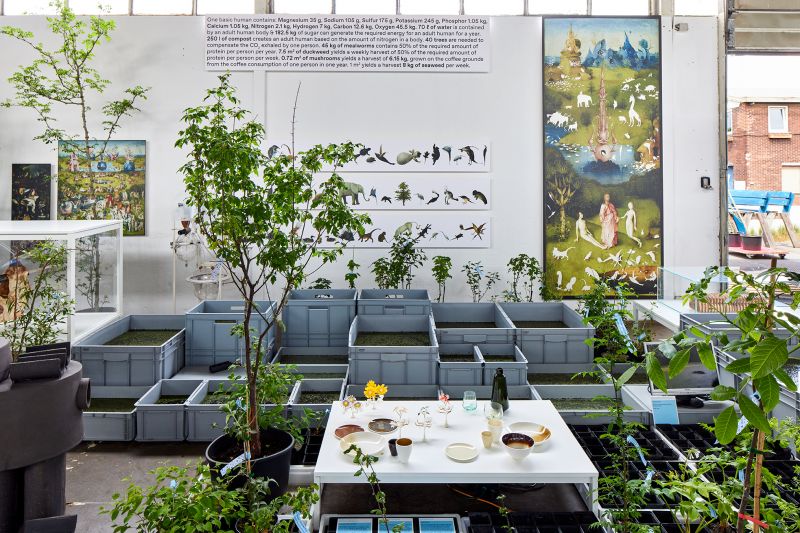
DOWN TO EARTH: WATERSCHOOL M4H+
picture: Aad Hoogendoorn
Five Interventions in the Public Space
WATERSCHOOL M4H+ investigates how a range of new raw materials and resources can contribute to a sustainable society as well as to how the district can function as a learning production landscape. Which new forms of food production are interesting, for example, and (how) can M4H make room for them? What part can food and material production even play in an area that is being developed as a future robust live-work district?
With (animal) species such as insects, the water intensity of meat production can be tested. Insects can serve as an alternative source of protein, the production of which requires much less water than the production of beef, pork, or chicken. Similarly, duckweed, seaweed, wood, or fungi are potential new food and material sources, the production of which leaves a smaller water footprint than current food production, although they will require new forms of (urban) agriculture, architecture, and energy supply. Can we perhaps extract the required energy from water, for example by the use of aquifer thermal energy systems? And what part can the existing port architecture play in these new forms of urban development?

Waterschool M4H+ outdoor installation
image: Aad Hoogendoorn
At five different outdoor locations in the M4H district stories about, research into, and the impact of new resources are illustrated in spatial installations. Each installation has its own subject and material and their stories are integrated in the story of how people may live and work here in the future. Using a QR code, visitors can access a web application that introduces pioneers in the district, makers and entrepreneurs already locally active as well as future residents. 3D drawings illustrate what the future live-work environment can look like if it is constructed using wood.

Waterschool M4H+: Artist's Impression Wood Production Landscape
image: Studio Makkink & Bey with Juhee Hahm
Water Footprint
According to surface area, each of the five installations shows the amount of water consumed directly, that is, for daily use, by the average inhabitant of Rotterdam: 119 liters per day. In order to supply this using rainwater, the average Rotterdammer needs about 60 m2 of space with a height of 72 cm, 43,435 liters for a whole year.
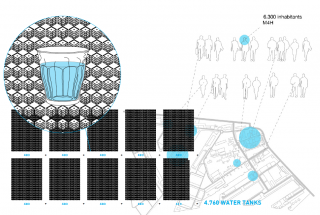
Waterschool M4H+: Artist's Impression Calculating the Waterfootprint
image: Studio Makkink & Bey
In addition, the installations show the impact that products such as food and clothing have on people’s water consumption and what this means in terms of water consumption worldwide. Because as a consumer, the average Rotterdammer indirectly consumes another 4,000 liters of water a day – 1.45 million liters a year. This means that the products we buy are responsible for 99 per cent of the water we consume. For the most part, such products are imported. This means we leave 95 per cent of our water footprint abroad, almost always in areas where the water conditions are much worse than in the Netherlands. The aim of the Waterschool is therefore to increase our awareness of our huge water footprint and to teach us what we can do about it, using the installations and in workshops and debates, and to continue to introduce the results in the central working exhibition.

DOWN TO EARTH: WATERSCHOOL M4H+
image: Aad Hoogendoorn
Expanding
The exhibition itself will incrementally develop as more information comes in from the district. In this way, as the exhibition continues, it will expand by addressing all of the subjects and results of the research by design into those raw materials that can serve as (building) materials or food and have a responsible relationship to water use with an eye to the sustainable development of Merwe-Vierhavens.
WATERSCHOOL M4H+ was realized with the support of Programmabureau M4H, a joint venture of Rotterdam Port Authority and the municipality of Rotterdam
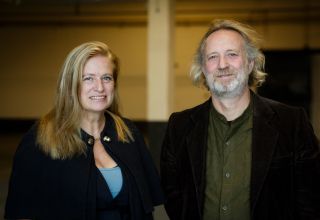
picture: Fred Ernst
Makkink and Bey
The curators of DOWN TO EARTH: WATERSCHOOL M4H+ are designer-architect Rianne Makkink and designer Jurgen Bey. Their design collaborative Studio Makkink & Bey is based in the M4H area in Rotterdam. Supported by a diverse design team, the Studio has been operating since 2002. The Studio's various projects include interior design, product design, public space projects, architecture, exhibition and shop window design, research projects and applied arts.
DOWN TO EARTH: WATERSCHOOL M4H+ will be open to the public from Wednesday June 9 through Friday July 30, 2021.
Please note that we're open from Tuesday to Sunday, from 11 am to 5 pm. We are always closed on Mondays.
Admission is free and registration is not necessary as long as the current corona measures are in force.
For all other pertinent visitors information, click here
ALL DATES ARE SUBJECT TO CHANGE
Given the pandemic, IABR follows the current guidelines of the Dutch Health Authority. So please remember that because of Covid-19 all dates are subject to change.
